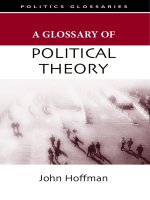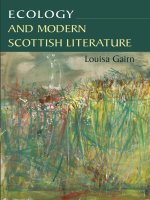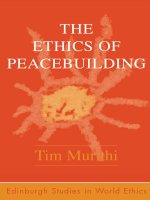edinburgh university press neolithic scotland timber stone earth and fire aug 2006
Bạn đang xem bản rút gọn của tài liệu. Xem và tải ngay bản đầy đủ của tài liệu tại đây (3.19 MB, 273 trang )
T I M B ER, STONE, E A R T H A N D FI R E
N E O L I T H I C S C O T L A N D
TI MBER, STONE, E ARTH A ND FIR E
This account of Scotland’s Neolithic period – from its earliest traces around 4000 BC to the
transformation of Neolithic society in the Early Bronze Age 1,500 years later – synthesises and
interprets excavations and research conducted over the last century and more. It brings together all
the available evidence essential to understanding the first farming communities of Scotland. And,
using a range of social theory, the author provides a long-term and regionally based interpretation
of the period, suggesting new directions in the study of the Neolithic.
After outlining the chronology and material culture of the Neolithic in Europe, Gordon Noble
considers its origins in Scotland. He suggests that differences in the nature of the Mesolithic–
Neolithic transition explain why the Earlier Neolithic in Scotland is characterised by regionally
distinct monumental traditions and, further, that these reflect different conceptions of the world.
He uses a longer-term perspective to examine the nature of monumental landscapes in the Later
Neolithic, and to consider how Neolithic society as a whole was created and maintained through
interactions at places in the landscape where large-scale monuments were built. He ends by
considering how the Neolithic was transformed in the Early Bronze Age through the manipulation
and re-use of the material remains of the past.
A comprehensive and up-to-date account of the Scottish Neolithic, this book is essential reading
for all those interested in the field.
Gordon Noble holds a Postdoctoral Fellowship in the Department of Archaeology, University
of Glasgow.
GORDON NOBLE
N E O L I T H I C S C O T L A N D
G O R D O N NOBLE
Front cover image (main): Fintray Cursus © Aberdeenshire Archaeology Service
Cover design and cover photo (top) of Hill of Tarvit: Cathy Sprent
Edinburgh University Press
22 George Square
Edinburgh EH8 9LF
www.eup.ed.ac.uk
ISBN 0 7486 233 8 8
N E O L I T H I C S C O T L A N D
TIMBER, STONE, EARTH AND FIRE
G ORDO N N O BL E
EDINBURGH
‘Fresh and exciting … required reading for any archaeologist.’
Richard Bradley, Professor of Archaeology, Reading University
‘Highly unusual in providing a sophisticated interpretative account of a wide range of
material for the Scottish Neolithic; perhaps more important is its focus on materiality
which, to my mind, is the essential future route of Neolithic studies.’
Dr Colin Richards, University of Manchester
N S
T,S,E F
Gordon Noble
Edinburgh University Press
© Gordon Noble, 2006
Edinburgh University Press Ltd
22 George Square, Edinburgh
Typeset in Minion by
Servis Filmsetting Ltd, Manchester and
printed and bound in Great Britain by
MPG Books Ltd, Bodmin, Cornwall
A CIP record for this book is available from the British Library
ISBN-10 0 7486 2337 X (hardback)
ISBN-13 978 0 7486 2337 2 (hardback)
ISBN-10 0 7486 2338 8 (paperback)
ISBN-13 978 0 7486 2338 9 (paperback)
The right of Gordon Noble to be identified as author of
this work has been asserted in accordance with the
Copyright, Designs and Patents Act 1988.
Contents
List of figures vi
Preface x
Introduction 1
1. Scotland in the Neolithic: an introduction 7
2. Islands in the fast lane: the Mesolithic-Neolithic transition 24
3. Burning down the house: the destruction of timber structures 45
4. Planting trees, planting people: long and round barrows in eastern
Scotland and beyond 71
5. Megalithic architecture in Atlantic Scotland 102
6. The emergence of monument complexes 139
7. The architecture of monumental landscapes 194
8. The Early Bronze Age: deconstructing and rebuilding the past 219
Conclusion: timber, stone, earth and fire 233
Bibliography 238
Index 260
Figures
1.1 The ‘agricultural frontier’ 8
1.2 Scotland in Europe 10
1.3 Areas and regions mentioned in the text 11
1.4 The geographical zones of Scotland 11
1.5 The composition of the woodland in Earlier Neolithic Scotland 13
1.6 The regional monument traditions of Earlier Neolithic Scotland 16
1.7 The changing forms of Neolithic pottery 18
2.1 The tides and currents of the sea 25
2.2 The island chains of the western British Isles 27
2.3 The major sea-routes in the Irish Sea zone 30
2.4 The brooding presence of the Isle of Man 31
2.5 Glecknabae chambered cairn 34
2.6 Machrie North 38
2.7 Earlier Neolithic field boundary and agricultural area near Brodick 39
2.8 Shetland: a Neolithic landscape 41
3.1 The distribution of pit-defined cursus monuments in Scotland 46
3.2 The radiocarbon dates for timber structures in lowland Scotland 47
3.3 The enclosure at Holywood North 48
3.4 Kirkburn, Lockerbie 49
3.5 The timber halls at Balbridie and Claish 50
3.6 The enclosure at Inchtuthil 50
3.7 The enclosures at Bannockburn 51
3.8 Douglasmuir 52
3.9 House 2, Coolfore, Co. Louth 53
3.10 Cloghers, Co. Kerry 53
3.11 Enagh Townland, Co. Derry 54
3.12 Ballyharry, Co. Antrim 54
3.13 Drummenny Lower, Co. Donegal 55
3.14 Chapelfield Cowie 60
3.15 Lamb’s Nursery Structure A 60
3.16 Deer’s Den, Aberdeenshire 61
3.17 Kinbeachie Farm 62
3.18 The pits at Blairhall Burn 63
3.19 Boghead mound 63
3.20 Radiocarbon dates for Neolithic settlement sites in lowland Scotland 65
3.21 The pits to the southeast of Douglasmuir 67
4.1 The distribution of long and round mounds and cairns in Scotland 72
4.2 Radiocarbon dates for timber structures 73
4.3 Aldwincle I, Northamptonshire 74
4.4 Fussell’s Lodge 75
4.5 Exposure platforms: Scott’s interpretation 76
4.6 A section through the mound at Fussell’s Lodge 77
4.7 The sequence at Pitnacree 79
4.8 Pitnacree: detail 80
4.9 The sequence at the Slewcairn 81
4.10 The sequence at Lochhill 82
4.11 The primary phases of Dalladies long barrow 84
4.12 The full sequence at Dalladies 85
4.13 Sections through Dalladies long barrow 86
4.14 Wayland’s Smithy 87
4.15 Detail of the split trunks at Wayland’s Smithy 88
4.16 Street House 89
4.17 Nutbane 91
4.18 Dooey’s Cairn, Co. Antrim 92
4.19 The forest 95
4.20 Trees of the past and the future 97
4.21 The trunk 98
4.22 Decay 100
5.1 The regional traditions of megalithic architecture in Scotland 103
5.2 An idealised Clyde Cairn 104
5.3 (a, b, c) Radiocarbon dates for chambered cairns in Scotland 106–8
5.4 The primary cairns at Mid Gleniron I 109
5.5 The cairn at Mid Gleniron I after enlargement 109
5.6 Mid Gleniron II primary cairn 110
5.7 Mid Gleniron B 110
5.8 Mid Gleniron II after cairn enlargement 111
5.9 Isometric drawing of Cairnholy I 112
5.10 A section through Cairnholy I 113
5.11 Phase 1 Achnacreebeag 114
5.12 Phase 2 Achnacreebeag 115
5.13 Calf of Eday 116
5.14 Papa Westray North 117
5.15 Anderson’s sketch of Camster Long 119
5.16 Tulach an t’Sionnaich 120
5.17 Embo 122
5.18 Balvraid 122
5.19 Vementry 123
5.20 Craonaval 124
F vii
5.21 Oban nam Fiadh 125
5.22 Rudh’ an Dunain 125
5.23 Notgrove 126
5.24 Ty Isaf 127
5.25 Pipton 128
5.26 Dyffryn Ardudwy 129
5.27 Trefignath 129
5.28 Primary cairns from across Britain 130
5.29 Camster Long forecourt 131
5.30 Midhowe, Orkney 135
6.1 The monument complex at Balfarg 142
6.2 Radiocarbon dates for Balfarg and Balfarg Riding School 143
6.3 Balfarg Riding School 144
6.4 Balfarg henge 145
6.5 Balbirnie stone circle 146
6.6 The location of North Mains henge 147
6.7 Radiocarbon dates for North Mains 148
6.8 North Mains henge and timber circle 149
6.9 The location of Cairnpapple Hill henge 150
6.10 Cairnpapple Hill henge 151
6.11 The Upper Clyde Valley 152
6.12 Blackshouse Burn 153
6.13 Radiocarbon dates for Blackhouse Burn 154
6.14 Meldon Bridge 155
6.15 Radiocarbon dates for Meldon Bridge 156
6.16 Dunragit (site) 157
6.17 Dunragit 158
6.18 Radiocarbon dates for Dunragit 159
6.19 Droughduil mound 159
6.20 Twelve Apostles, Holywood North and South and Holm 160
6.21 The relationship between Holywood and Twelve Apostles 161
6.22 Machrie Moor 162
6.23 The Earlier Neolithic features at Machrie Moor 163
6.24 Radiocarbon dates for Machrie Moor 164
6.25 Machrie Moor timber circles 165
6.26 Machrie Moor stone circles 165
6.27 Kilmartin Glen 166
6.28 Upper Largie 167
6.29 Temple Wood 167
6.30 Temple Wood as it survives today 168
6.31 Carvings at Achnabreck 169
6.32 Callanish 170
6.33 Callanish I 171
6.34 Radiocarbon dates for Callanish 172
viii N S
6.35 The Stenness-Brodgar complex 174
6.36 The Stones of Stenness 175
6.37 Radiocarbon dates for the Stenness-Brodgar complex 176
6.38 Maeshowe 177
6.39 Howe 179
6.40 The Ring of Brodgar 180
6.41 Leadketty, Perthshire 182
6.42 Rectangular timber structures from the fourth millennium 183
6.43 The location of the Upper Clyde Valley 189
6.44 Henges and motorways 191
7.1 The layout of one of the houses at Barnhouse 199
7.2 House 7 at Skara Brae 201
7.3 House 2 at Barnhouse 202
7.4 Beckton Farm 203
8.1 An Early Bronze Age cist burial 220
8.2 Forecourt blocking at Cairnholy 223
8.3 Blocking at Mid Gleniron I 224
8.4 Auchategan, Cowal: Neolithic settlement 225
8.5 Early Bronze Age phase at Auchategan 226
8.6 Early Bronze Age reuse of Pitnacree mound 227
8.7 Embo 228
F ix
Preface
My first excavation experience was at a stone circle in Aberdeenshire. At the time I was
studying the History of Art at the University of Aberdeen. I remember phoning the
excavation director and asking if I could come and dig. He said,‘Hold a minute, I just
have to lie behind the spoil heap so that I can hear you!’ At that stage I didn’t really
know what a spoil heap was and was rather confused by the whole event, so much so
that I thought about not going after all, as I was unsure of what to expect. After two
weeks of digging on top of a hill in freezing conditions, occasionally having to clear
snow off the trench before we could dig, I was hooked. I was hooked because I loved
the excitement of trying to imagine the past and loved handling objects that people
had touched and used thousands of years previously. On the last day of my time there
I found a beautiful flint blade that was one of the best finds of the whole excavation.
After that there was no turning back. The same year, I went to Orkney and after vis-
iting sites like Skara Brae and Maeshowe I realised that archaeology was something
I’d like to pursue further. Subsequently I wrote my final year History of Art disserta-
tion on the architecture of Neolithic chambered cairns in Orkney and after a year in
London, a Ph.D. in Reading and now this book, it is safe to say that I am still enam-
oured by the whole process of archaeological investigation.
The director of the Tomnaverie excavation was Professor Richard Bradley of
Reading University and his unwavering support has been the main reason for my suc-
cessful transition from art historian to archaeologist. I now know very well what a
spoil heap is and I would like to thank Richard for allowing me to contribute to the
one at Tomnaverie and for all his help and guidance in the completion of this book
and for his excellent supervision in my Ph.D. research. This book would not have
been possible without your inspiration.
The research for this book has also benefited from conversations and pints of
Te nnent’s with the following: Amanda Brend, Martin Carruthers, Martin Goldberg,
Tessa Poller, Meggen Gondek, Kylie Seretis, Fay Stevens, Kenny Brophy, Steve
Timoney and Gavin MacGregor. Meggen and Tessa also read large chunks of the
manuscript. Most of all, thanks and love should be expressed towards my family who
have always supported me: Mum, Dad, Graeme, David, Marie-Anne and Luke (Luke
Luke I am your uncle), the Davidsons, Helen, Doug and Megan.
Marianne, I’ve dug a lot of sites now, but you are still my best find . . . .
Introduction
T
The research undertaken for this book draws on a number of current themes in
Neolithic archaeology. One of major themes is the idea of regional variation. There
has been a growing awareness of the diversity of the Neolithic archaeological record
in Scotland in recent years. The need for regional interpretation has been promoted
and this book attempts just such an undertaking (Ashmore 1996; Barclay 1997, 2000,
2001a).
As well as looking at regional sequences, it is also important to account for the ways
in which regions interacted to make up Neolithic society as a whole. Julian Thomas
has highlighted the continuing need for wider considerations of ‘how we conceive
broader historical trajectories’ (Thomas 1998: 38). In this book regional considera-
tions of monument and settlement traditions have been linked to wider considera-
tions of Neolithic society in Scotland. The study employs differing scales of focus
throughout. There are few archaeology books that now attempt to consider larger
geographical regions that incorporate a number of regionally distinct archaeologies.
Academic studies in recent decades have focused on regional sequences of change.
While this is a valid approach, there is little consideration of how local lifestyles and
social traditions interacted with one another to create the wider Neolithic world. This
often produces a sense of isolation, both in the past and in the present. Archaeologists
who work on regional material often loose sight of wider trends in prehistoric archae-
ology and their interpretations often fail to consider how regional communities
understood and reacted to the wider Neolithic world.
The second major theme of this book is an attempt to remedy an imbalance in the
Scottish and British Neolithic by moving the focus away from well-studied areas such
as Orkney that have dominated considerations of the Neolithic in Scotland. The
Orkney Islands have been extensively studied since the early days of archaeology;
Gordon Barclay terms Orkney one of British prehistory’s ‘core areas’, not necessarily
due to its importance in the past, but due to the prominence of this area in current
and past archaeological fieldwork (Barclay 2000, 2001a). Orkney’s prominence has
led to a disparity in accounts of the Neolithic where large areas of Scotland are
ignored in major syntheses. In this book regions not widely considered in the past are
studied in detail. Good syntheses and studies of Orkney are already available
(Davidson and Henshall 1989; Fraser 1983; Hedges 1984; Renfrew 1979; Richards
1988, 1992a, 1992b, 1996b, 1998). The shift in focus is designed to incorporate lesser
known sites and traditions of monuments into wider considerations of the Neolithic.
The remains of timber structures in eastern Scotland, while not as spectacular as
some of those surviving in the north, can provide as rich a resource for understand-
ing the past as their more famous stone counterparts.
Each chapter of this book considers different aspects of Neolithic Scotland, from
the earliest traces of the Neolithic to the transformation of society in the Early Bronze
Age. The following chapter considers the issue of the Mesolithic-Neolithic transition.
Early archaeologists such as Gordon Childe and Stuart Piggott thought that farming
and associated material culture was brought to the islands by incoming settlers
(Childe 1935; Piggott 1954), however more recent writers have argued for a greater
contribution to change by the local Mesolithic population, through the adoption of
aspects of a farming lifestyle in traditional hunting and gathering lifestyles (Bradley
1993, 1998; Thomas 1988, 1991, 1999a; Whittle 1996). Interpretations in the 1990s
focused on the importance of changes in ideology and world-view in indigenous
society during the transition to farming, but opinion in the last few years has since
begun to swing in the opposite direction, with some archaeologists now arguing that
some form of population movement may have been involved after all in the onset of
the Neolithic (Richards 2003; Schulting and Richards 2002; Sheridan 2000). This is,
in part, driven by advances in archaeological science and in particular the develop-
ment of stable isotope studies where ancient diets can be reconstructed through the
analysis of particular chemical signatures in human bone (Schulting and Richards
2002). This has revealed a much greater reliance on land-based, most probably
domesticated, resources from the Earlier Neolithic onward than had hitherto been
supposed. Chapter 2 is inspired by this debate and attempts to examine the nature of
the transition through a detailed consideration of the archaeology of Scotland and
the adjacent islands. Here it is argued that ideas about the transition have been overly
simplistic and that it is essential that regional differences are accounted for in inter-
pretations of this major process of change. I argue that critical to an understanding
of the transition in the British Isles is a consideration of maritime culture and sea
travel. Boats and seamanship were amongst the most complex technologies and skills
in prehistory. The expertise involved in maritime activity is restricted and certain
communities are often better placed to develop technologies of the sea. Small island
communities in Scotland and Ireland utilising the Atlantic seaways may have been
crucial to the adoption of Neolithic lifestyles. The archaeological record of the island
communities of the west contains significant differences from adjacent mainland
areas during the period of the Mesolithic-Neolithic transition. The Atlantic sea-
routes that led up the west coast of Britain may have been instrumental in enacting
change at the beginning of the Neolithic and there may have been significant
differences in the nature of the transition in eastern and western Scotland.
Chapter 2 acts as a further introduction to the archaeology and geography of
Scotland. In particular it develops the distinction between Atlantic Scotland in the
2N S
west, made up of a pattern of islands, and eastern, lowland Scotland. This distinction
is crucial to the next three chapters, where the major regional traditions of Earlier
Neolithic monuments are outlined in detail and their form and characteristics exam-
ined. Differences in the nature of the Mesolithic-Neolithic transition seem to have
aided the creation of very distinct Neolithic worlds, where different styles of monu-
mental architecture, artefact style and lifestyle were found in eastern and western
Scotland. The regional traditions of monuments symbolised diverse ideas about the
world, inspired by the different environments and lifestyles present in these areas. The
geography of the British Isles allowed contact with markedly divergent areas of
Europe and the monument traditions of Earlier Neolithic Scotland reflect this. In
western Scotland the chambered cairns are part of an Atlantic tradition of megalithic
architecture concentrated in areas to the south in France and Iberia. In eastern
Scotland a series of timber monuments are related to styles of monument found in
northern and central Europe and the history of these monuments can be traced back
to the very core origins of the Neolithic in Europe (Bradley 1998: chapter 3; Bradley
2002: chapter 2; Childe 1949). These separate traditions require different approaches
in interpretation and this is the purpose of Chapters 3 to 5.
Chapter 5 examines western Scotland and the construction of megalithic tombs.
Excavations at chambered cairns in western Scotland have shown that these monu-
ments are the result of a number of distinct periods of construction. Through
detailed analysis of the altering nature of the architecture of these monuments it is
possible to link these changes with a transformation in the relationships between the
living and the dead in Neolithic society. The secondary phases of many of these cairns
involved increasing the capacity of these monuments and adding areas for public
display. These changes can be seen as being related to the growing importance of
remembering the dead, aided by drama, performance and concepts of ancestry.
In Chapter 4 the focus shifts to eastern Scotland, where timber was the main
medium through which ideas about the world were symbolised. Split tree trunks
placed under long and round barrows has often been explained in functional terms,
but I argue that the tree may have been used as a symbol in rituals that highlighted
processes of life and death. Cursus monuments in eastern Scotland also involved the
manipulation of timber and natural symbols (Chapter 3). However, the rituals and
performances at these monuments involved building post enclosures that were then
burnt down, creating a dramatic spectacle. In Scotland, these pit-defined cursus mon-
uments and other associated traditions seem to be related to Neolithic settlement
patterns and the building of such structures may have been intended as memorials to
past inhabitations and the use of significant places.
Chapters 6 and 7 move the discussion onto the Later Neolithic period. In the Later
Neolithic many of the regional traditions of architecture present in the earlier period
ceased to be built, and in their place styles of architecture and material culture
reflecting larger and more long-distance contacts can be identified. In the Later
Neolithic, the locations of earlier monuments were augmented by the construction of
further monumental structures, creating what has been defined as ‘ceremonial’ or
‘monumental’ complexes, landscapes where a wide range of structures, of more than
I 3
one period, are found in close proximity. Chapter 6 outlines the major ceremonial
complexes of Scotland, focusing in particular on landscapes where there are reason-
able levels of contextual information on the monuments themselves and their sur-
rounding environment. Chapter 7 then proceeds to interpret the ways in which
monumental complexes functioned in Neolithic society. It is argued that economy
and monument building were intertwined at monument complexes, with complexes
at the centre of a network of paths that led across the landscape and across the sea. In
this respect, Neolithic society was maintained and renewed through community
interaction at these places. Chapter 8 completes the discussion of Neolithic Scotland
by looking at the ways in which the Neolithic society was transformed in the Early
Bronze Age, examining how the material traces of the Neolithic were manipulated
and reused at this time.
This book is a synthesis and interpretation of countless excavations and previous
interpretations of the Scottish Neolithic and draws too on wider European traditions
of prehistoric studies. Its inspiration draws on the sentiments of Gordon Childe
expressed as long ago as 1935 in his landmark study The Prehistory of Scotland:
This book, which must appeal to a wider public, cannot take the place of such
detailed technical studies which can only appear in learned periodicals. The data
it presents are accordingly incomplete, the conclusions it tentatively offers are
provisional or even premature. Its aim is to stimulate interest among the mass of
Scottish people, to suggest lines for more intensive and systematic research and
to reveal the significance of Scottish prehistory to students abroad. To that end
it is essential to attempt a synthesis in the light of the new knowledge and new
conceptions that intensive research and international co-operation have estab-
lished. (Childe 1935: xi)
The Scottish Neolithic presented in this book would be barely recognisable when
compared to the one Childe studied in the 1930s, yet I hope he would have approved
of the aims of this book which were to produce a volume that considers the entirety
of the Scottish Neolithic, no matter how tentative, general or provisional the conclu-
sions may be. The Neolithic communities of Scotland left some of the most spectac-
ular archaeological remains in Western Europe; I hope this book conveys some of the
interest and understanding of the past that can be gained through their study.
A S N :
S
Scotland formed an important arena for some of the pioneering research into the
study of the European Neolithic and prehistoric archaeology in general in the nine-
teenth and early twentieth centuries. Archaeologists like Wilson, Abercromby, Munro
and Anderson, working largely on Scottish material, promoted new forms of
European prehistory that provided important frameworks for the study of the past
(Childe 1935: xi; Kinnes 1985; Piggott 1983).
4N S
Joseph Anderson in particular considerably advanced the study of prehistory and
set out a manifesto for the study of archaeology as a discipline: ‘It may be possible,
from purely scientific materials, by purely scientific methods, to construct a logical,
though not a chronological, history of culture and civilisation’ (Anderson 1886:
386–7). Anderson emphasised the importance of interpreting material culture as a
method for studying the past. As he recognised himself, he was hampered by the lack
of an absolute chronology, but this did not prevent him from constructing a coher-
ent narrative about Scottish prehistory. Anderson completed a number of important
excavations on chambered cairns in Scotland and the discussion of the results of this
fieldwork formed much of his discussion of the Neolithic in Scotland in Pagan Times
(1886). Anderson’s work at times was almost purely descriptive, but he recognised
many of the important features of the Scottish Neolithic: the successive nature of
burial in chambered cairns; the close relationship between houses and tombs; the
regionally distinct nature of the Neolithic; and the links between forms of material
culture found in widely dispersed areas. Throughout Anderson’s account his won-
derment and amazement at the achievements of the prehistoric communities of
Scotland was obvious. His admiration for the past was much more admirable than
many of his contemporaries’ accounts of prehistoric ‘savages’.
Anderson’s book on the Scottish Neolithic was largely based on the remains of
chambered cairns that due to their constituent materials have survived well into the
present. Consequently, Anderson’s account had a western focus; the Neolithic in the
eastern lowlands was poorly recognised and represented largely by artefacts found
during agricultural activity with little context (Anderson 1886: 306).
The study of Scottish prehistoric archaeology in the early twentieth century was
dominated by Gordon Childe and Stuart Piggott, both of whom held the prestigious
Abercromby Chair of Archaeology at Edinburgh University from 1927 to 1946
(Childe and Piggott from 1946 to 1977). Childe saw Scotland as a ‘theatre of prehis-
toric migrations and settlement’ and his narratives drew on the principles of culture
history that explained change through reference to successive waves of migrants
(Childe 1935: 3). Like Anderson, Childe’s account of the Scottish Neolithic was
mainly concerned with the chambered cairns of western Scotland and before the
advent of radiocarbon dating, Childe’s chronological understanding was confused.
Childe thought the chronologically later Early Bronze Age burials of eastern Scotland
were contemporary with the chambered cairns and consequently the Neolithic of
lowland Scotland was largely unaccounted for (Barclay 2001a: 10). Childe proposed
that the Neolithic in Scotland had been introduced by Iberian colonists in boats
coasting up the Atlantic western coast, their boats crewed by English crew members,
laden with all the elements of the Neolithic ‘package’: domestic animals and cereals,
pottery and stone axes (Childe 1935: 77–8).
Stuart Piggott’s work was also concerned with the origins and diffusion of incom-
ing settlers (Piggott 1954, 1958). Eastern Scotland was also a ‘virtually unknown
territory’to Piggott (Barclay 2001a: 11). Piggott’s Neolithic was condensed into five
centuries, rather than the period of at least 1,500 years that we recognise today, and
consequently Piggott’s account of the period was one thought to consist of rapid
I 5
change (Piggott 1954: 380–1). The monuments that represented the Scottish Neolithic
were thought to be late, adopted at a later stage of the Neolithic from more advanced
cultures to the south (Piggott 1958: 30).
It is only with the work of the Royal Commission since the Second World War and
the use of aerial photography in archaeology that a more balanced view of Scottish
prehistory been possible (Barclay 2000, 2001a). The identification of crop mark sites
from the air (the remains of decayed timber and earth monuments and sites) has rev-
olutionised our understanding of the Scottish Neolithic. Numerous sites have been
identified in eastern Scotland using this technique and the excavation of these sites
has revealed a previously unrecognised wealth of information about Neolithic
lifestyles. In particular the excavation of lowland sites such as North Mains, Balfarg
and Dunragit has significantly extended the range of material that we can use in
accounts of Neolithic Scotland (Barclay 1983; Mercer 1977–8; Thomas 2001b). It is
only in more recent years that a more comprehensive view of the Scottish Neolithic
has been possible. This is an exciting era for Neolithic studies.
6N S
CHAPTER ONE
Scotland in the Neolithic: an introduction
I
After the end of the last Ice Age, some 12,000 years ago (c. 10000 ), the first human
societies started to move into the area of what is now modern Scotland. These peoples
were hunter-gatherers who lived a largely mobile existence following herds of
animals. They moved around the landscape to obtain food, resources and to maintain
social contacts. These hunter-gatherers belong to the archaeological era called the
‘Mesolithic’ or Middle Stone Age (c. 9000–4000 in Scotland). They shared much
in common with hunter-gatherer communities spread across the British Isles and
beyond in Western and Central Europe (Wickham-Jones 1994; Saville 2004).
Mesolithic Scotland was a very different place to that of modern Scotland. The
initial post-ice, tundra-like landscape was soon transformed into a forest world; most
of the landscape was cloaked with trees. Within this forest environment Mesolithic
communities lived, their world governed by pathways through the forest, linking
families and individuals in dispersed social ties. These communities, like many
hunter-gatherer societies today, had close relationships with the surrounding natural
world. The exact nature of Mesolithic life is difficult to ascertain. Finding information
on such ancient communities is a hard task and one which archaeologists have only
recently begun to tackle. The hunter-gatherer communities of Scotland left few traces
of their lifestyle that are still evident today without excavation. Settlement structures
tended to consist of light wooden windbreaks or tent-like structures (Wickham-Jones
2004), the organic elements of which have long since rotted away, leaving only traces
in surrounding soils.
Mesolithic life continued for some 5,000 years in Scotland, before a significant
transformation occurred in the centuries leading up to the fourth millennium .
Around this time (c. 4000 ), the British Isles and the fringes of western Europe
came in contact with new ways of life associated with communities that practised the
agricultural routines of crop-growing and animal husbandry. This period of prehis-
tory is known as the Neolithic or New Stone Age and in the British Isles this era lasted
for over a millennium and a half (4000–2500 or between 4,500 and 6,000 years
ago). The Neolithic in Britain and Ireland is generally recognised as the period when
domesticated resources (cattle, sheep, cereals and so on) and new technologies (such
as pottery and different forms of stone tool) were introduced to the British Isles.
Farming had originally spread from its origins in the Fertile Crescent (an area in the
Middle East where the origins of agriculture are to be found) to southeast Europe
through population movement or through the movement of ideas and material
culture (Bradley 1998; Childe 1935; Sherratt 1990; Thomas 1991; Whittle 1996). The
British Isles were amongst the last locations in Europe to become Neolithic. A few
centuries previous to 4000 ,Britain and Ireland lay to the west of an ‘agricultural
frontier’, part of an increasingly smaller area of Europe that was not in direct contact
with farming societies (see Figure 1.1).
8N S
F 1.1 Britain and Ireland around 4500 situated to the west of an ‘agricultural frontier’
(Source: Bradley 1998: figure 4)
N
The Neolithic is not merely about the spread of agrarian technologies, but also
documents the spread of new ideas about life, death and the world around. In western
Europe the onset of the Neolithic, as well as being associated with the introduction of
domesticated resources, was also associated with the construction of elaborate timber
and stone monuments, monuments which often incorporated remains of the dead.
These monuments were associated with a range of beliefs concerning the natural
world, death, the regeneration of life and human-animal relationships. Monuments
have characterised the ways in which the Neolithic has been studied as these remain
the most visible elements of Neolithic life. In order to understand the spread of agri-
culture in western Europe we must also understand the ways in which monument
construction and heightened levels of ritualised activity became an integral part of
life in this part of the Neolithic world.
S
Physical geography
Scotland is a northern part of the British Isles, an island chain situated off the western
coast of the European mainland (Figure 1.2). Scotland is divided from its neighbour
England to the south by the Cheviot Hills, a range of uplands that run northeast to
southwest across northern England. That is not to say that Scotland was a recognis-
ably discrete and bounded area of the Neolithic world. As we shall see in the follow-
ing chapters, the area that is now Scotland was always connected to its neighbours,
England, Ireland and Wales, and at times to the European mainland, through a
complex network of contacts. This study often strays beyond the modern borders of
the present Scottish nation to examine the ways in which traditions of monuments
and material culture related to their wider distributions and contexts. Scotland itself
is a country of varying topography, landscape and climate and different areas of
Scotland have distinct characters that reflect contrasting relationships with the land
and sea.
Scotland is at the junction of a number of seaways: the Irish Sea, the Atlantic and
the North Sea. Hence, the area of Scotland has always been open to a variety of con-
tacts with a range of geographically distant lands. In particular, there are distinct
differences between the Atlantic areas of western Scotland and the North Sea areas of
the eastern coast. Contacts, historical and ancient, in the west have been predomi-
nantly across the Irish Sea and through the Atlantic sea-routes to the south and north,
whereas in the east, links with England to the south and areas across the North Sea to
the lowland countries of Europe have been predominant. These distinctions have
important implications for the way in which the Neolithic was introduced to these
areas and its subsequent development. Scotland is split into a variety of administra-
tive, historical and political areas to which reference will be made in the text. The
main regions and areas mentioned in the text are shown in Figure 1.3.
Scotland can be divided into three main geographical zones: the Highlands and
Islands, the Southern Uplands and the Central Belt (Figure 1.4). The Southern
Uplands are a series of gently rolling hills, which, while a significant feature in their
S N 9
own right, are much less formidable than the taller and more rugged Highland and
Grampian mountains which cover large parts of northern and western Scotland.
Settlement is severely restricted in the higher mountainous areas. In the north and
west of Scotland settlement today is mainly on the coastal fringes and on the islands.
The land of Scotland is of a higher average elevation than any other area in the British
Isles, consequently low-lying land in Scotland is restricted and in mainland Scotland
10 N S
F 1.2 Scotland in Europe
N
S N 11
F 1.3 Areas and regions mentioned in the text
F 1.4 The geographical zones of Scotland
N
N
the largest tracts are found in the Central Belt, on the coasts of Dumfries and
Galloway, in the Borders around the Tweed river, and in Aberdeenshire and Caithness.
This is not to say that settlement and agriculture was restricted to these areas. Today
the central lowlands are the most productive areas for agriculture in Scotland, but in
the past the differences between the coastal areas of western Scotland and the islands,
and the eastern lowlands may not have been as marked, especially in the more
favourable climatic conditions of the Neolithic (Coppock 1976: 10; Turnock 1974;
Whittington and Edwards 1997). The landscape of Scotland probably had greater
implications for movement and contact than it did for agricultural potential. The
upland areas form important barriers to movement; routeways across the landscape
would probably have followed the paths that were easiest to traverse, following the
major valley systems and rivers.
Environment
Scotland’s environment in the Mesolithic and Neolithic has been reconstructed
through the work of palynology, the analysis of pollen remains from lake and peat
deposits. The techniques of palynology can give us a generalised picture of the natural
distribution and composition of Scotland’s woodlands after the ice retreated (Tipping
1994; Edwards and Whittington 1997; Edwards 2004). The last major glaciation in
northwest Europe is known as the Weichselian. At its peak the Weichselian covered
the entirety of Scotland and large parts of England; the ice almost a kilometer thick
in places (Wickham-Jones 1994: 45). The Weichselian withdrew from Scotland
around 10000 (around 12,000 years ago). The reprieve was brief, however. Soon
after, the climate became cold again in a period known as the Loch Lomond Stadial,
and a number of mini glaciers formed. While not as extensive as the earlier glaciation,
it is likely that few large plant species survived this latest period of glaciation (Tipping
1994: 9). After a short period, conditions improved and the ice finally disappeared
and trees and larger plant species returned to the area of modern Scotland. Tree
species migrated from England and the adjacent Continent, attracted by the warming
climate (Tipping 1994: 9). Birch and hazel were the first tree species to colonise the
area on a large scale, in the ninth millennium (9000–8000 ). Some considerable
time later, elm and oak also began to appear in Scotland and by the fifth millennium
,all of the major tree species of Scotland were extensively distributed across the
landscape (Figure 1.5). Woodland reached its fullest distribution shortly before the
beginnings of the Neolithic and at the beginnings of the fourth millennium forest
dominated much of the landscape, except perhaps in the north and west where there
may have been lighter cover (Tipping 1994; Edwards 2004). In southern Scotland oak,
elm and hazel were the main woodland species, whereas in northeast Scotland, birch
and hazel trees were the main constituents with only a small proportion of oak and
elm. In the west and north, woodland was less dense in composition with open stands
of birch and hazel; the more recent colonisers of oak and elm made little impact on
these areas. All of these woodlands would have contained a range of other tree and
plant species including meadowsweet, poplar, plantain, fern, cherry, willow, ash, and
myrtle (Tipping 1994: 11).
12 N S
S N 13
F 1.5 The composition of the woodland in Earlier Neolithic Scotland
(Source: Edwards 2004)
Human impact
There has been tentative and not entirely unambiguous evidence for human impact
on the natural woodland in the Mesolithic (Edwards and Hirons 1984; Edwards and
Ralston 1984; Tipping 1994). The difficulty has been differentiating between possi-
ble human impacts and more natural causes. In some locations, however, there are
possible indicators that woodland was burnt by Mesolithic people perhaps to encour-
age the development of areas of grazing for animals. In the Neolithic, evidence for
clearance becomes more common, widespread and less ambiguous. The Neolithic in
Scotland, and western Europe generally, was formerly thought to be marked by a phe-
nomenon in palynological records known as the elm decline. The elm decline was a
period c. 4000 ,around the generally recognised beginnings of the Neolithic, that
was marked by a sudden and widespread reduction in elm trees. The exact causes of
this reduction is now hotly debated and a range of causal factors have been suggested
from climate change to tree disease to soil deterioration, along with more traditional
accounts of human impact (Tipping 1994: 22; Edwards 2004: 57). Human impact on
the woodland in the Neolithic is generally thought to be associated with clearance for
the growth of cereal crops and to provide grazing areas for domesticated animals.
Whether the elm decline can be associated with the beginnings of the Neolithic or
not, many pollen diagrams do seem to show impacts on the tree cover from the
Earlier Neolithic onwards (Edwards 2004: 57). This can be accompanied by a rise in
the numbers of pollen indicators for species such as Plantago lanceolata (ribwort
plantain) which probably indicates some form of associated pastoral activity. Loch
deposits also often show increased rates of soil erosion in the centuries after 4000
across Britain and Ireland (Edwards 2004: 60). This too may be associated with the
onset of agricultural practices, but natural causes could also have contributed to the
increased rates of erosion. Cereal-type pollen should be a less ambiguous trace of
early farming, but cereal pollen is difficult to identify in the pollen record and can
be confused with wild native grasses (Edwards and Hirons 1984; Tipping 1994).
Cereal-type pollen has been identified in a number of pre-elm decline and hence pos-
sibly pre-Neolithic instances, but the interpretations and identifications of this are
not always secure. Earlier Neolithic clearance of woodland may have been most
effective in the north and west where there was only light woodland in the first
instance and soon after the beginnings of the Neolithic some of the islands and
northern areas of Scotland may have been relatively treeless (Tipping 1994: 24).
Destruction would have been exacerbated by use of the cleared land for crop growing
and animal grazing, inhibiting forest regeneration.
T N
Chronology
The Neolithic for the purposes of this study has been divided into two major periods:
the Earlier Neolithic and the Later Neolithic. Each period is characterised by different
forms of monumental architecture and material culture. The Earlier Neolithic
14 N S









